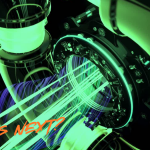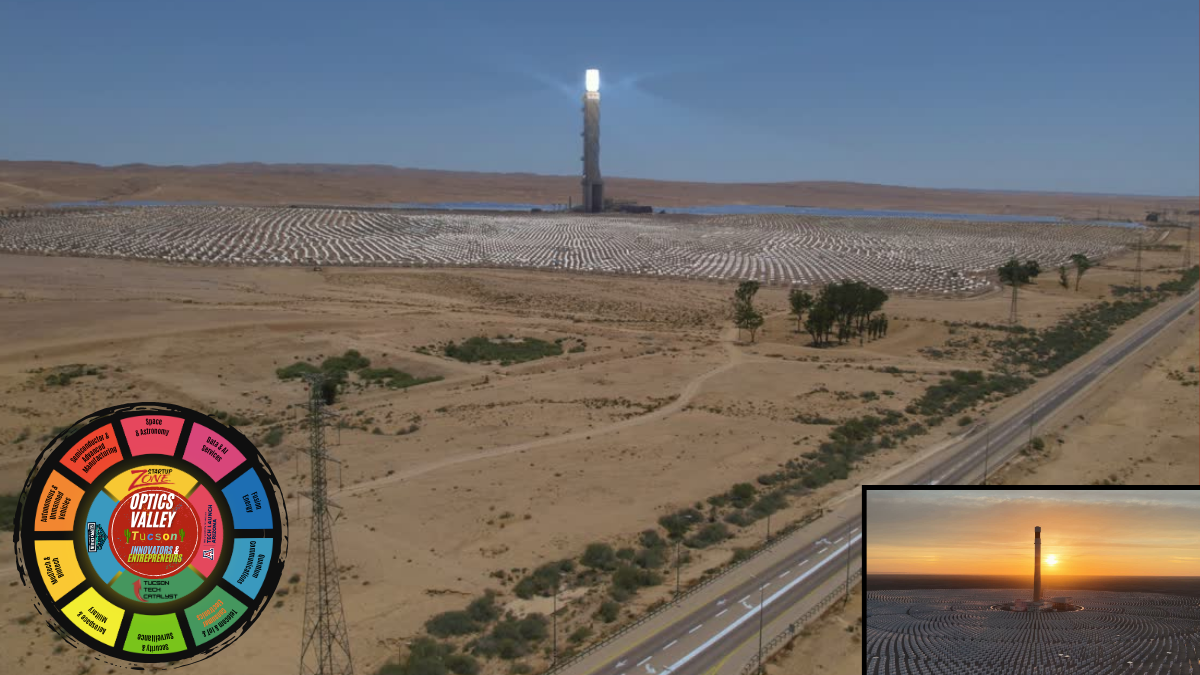Vaporize Salt with the Sun… Really?
Powering Solar Revolutions
Arizona is famous for sunshine over 280 clear days a year, but the real story isn’t about tanning weather. It’s about how that sunlight is being turned into serious power. At the University of Arizona (UA), researchers are pushing solar energy beyond flat panels and rooftop systems. They’re creating next-generation solar concentrator systems that focus sunlight so powerfully that it can melt salt, run engines, and even make hydrogen fuel.
This is the frontier of Concentrated Solar Power (CSP) and Concentrated Photovoltaics (CPV), and Optics Valley/Tucson sits right at its center.
What Are Solar Concentrators?
Solar concentrators act like giant magnifying glasses. Instead of spreading sunlight over a large surface like traditional solar panels, they gather and focus it on a smaller target called a receiver. That intense beam can heat fluids to hundreds, or even thousands, of degrees Celsius.
Some concentrators use curved mirrors; others use Fresnel lenses or fields of heliostats (sun-tracking mirrors). Once the sunlight is concentrated, the energy can be used in two main ways:
- CSP (Concentrated Solar Power): turns heat into electricity through turbines.
- CPV (Concentrated Photovoltaics): focuses sunlight onto super-efficient solar cells for direct electricity generation.
In both cases, the goal is to squeeze more energy out of every ray of sunlight.
Arizona’s Solar Powerhouse
Few places are better suited for solar innovation than Southern Arizona. The University of Arizona has spent decades developing new optical technologies for astronomy and clean energy. The same expertise used to build the world’s largest telescope mirrors is being applied to solar concentrator mirrors, lens systems, and precision tracking that keep beams locked onto targets as the sun moves across the sky.
At the heart of this work is the College of Optical Sciences, with visionaries like Dr. Roger Angel and Dr. Daewook Kim, and the Energy and Fuel Cell Laboratory, directed by Dr. Peiwen (Perry) Li. Together, these teams are advancing everything from shape-shifting heliostats to high-temperature molten salt systems.
The Magic of Moving Mirrors
Imagine a field filled with large mirrors that can twist and curve as the sun moves. That’s not science fiction, it’s fundamental research at UA.
Dr. Roger Angel’s team has developed a “shape-adjustable heliostat,” a mirror that can slightly bend throughout the day to keep the sunlight perfectly focused. Most heliostats tilt and turn, but their focus blurs when the angle changes. UA’s twisting mirror solves that problem, keeping the beam sharp from sunrise to sunset.
Tests show how this design could dramatically improve the temperature and efficiency of solar power towers. In fact, the system can reach over 1,500 °C, hot enough to melt metals and drive next-generation industrial processes.
This is the kind of engineering that could make solar thermal power not only greener but also cheaper.
The Secret Sauce: Molten Salt
So where does all that heat go once it’s captured?
Enter molten salts, the unsung heroes of concentrated solar power.
Molten salts are mixtures of nitrates (usually sodium nitrate and potassium nitrate) that melt around 220 °C and stay liquid up to 600 °C or higher. When sunlight is concentrated onto a receiver, these molten salts absorb and store the heat like a massive thermal battery.
At night or on cloudy days, the stored heat is used to generate steam and spin turbines, which produce electricity long after the sun goes down. It’s clean, efficient, and far more sustainable than running backup generators on fossil fuels.
UA’s Energy and Fuel Cell Laboratory focuses on improving these heat-transfer fluids and storage systems. Their research explores new salt mixtures that can withstand higher temperatures, metal alloys that resist corrosion, and heat exchangers that recover more energy. The goal: to build CSP plants that run hotter, last longer, and deliver electricity at a lower cost.
This molten salt research connects directly to the optical work because the better the concentrator’s focus, the hotter the salts can get. It’s a perfect marriage of optics, materials science, and mechanical engineering.
Hybrid Power: CPV Meets CSP
Another exciting development at the University of Arizona is the creation of hybrid systems that blend concentrated photovoltaics with thermal storage. These setups use mirrors to split the solar spectrum:
- One part of the light hits PV cells to make electricity.
- The rest is converted into heat and stored in molten salts.
A “two-for-one” solar system simultaneously produces instant electricity and bankable thermal energy. UA engineers are working on this hybrid approach with industrial partners and testing it in the blazing Arizona sun.
If it succeeds, it could solve one of solar’s biggest challenges: how to deliver power on demand, even after sunset.
From Lab to Landscape
The University of Arizona doesn’t just stop at theory. It operates one of the most extensive solar test beds in the United States, the Solar Zone at the UA Tech Park in Tucson. This site hosts multiple solar technologies: CPV panels, tracking systems, thermal collectors, and storage tanks. It’s a real-world laboratory where researchers can measure performance, reliability, and cost under desert conditions.
The data coming out of the Solar Zone feeds directly back into UA’s research labs, creating a continuous innovation loop between experiment and deployment.
Why It Matters
Solar concentrator technology could change how the world powers its industries and cities.
Unlike traditional PV, which only works while the sun shines, CSP with molten salt storage provides steady, dispatchable energy, which utilities can count on 24/7. It’s also perfect for industrial processes like hydrogen production, water desalination, and carbon-neutral fuels.
Arizona is positioned to lead this transformation with its abundance of sunshine and optical talent. Dr. Angel once said, “We already know how to focus starlight. Now, we’re learning to focus sunlight to save the planet.”
The Future is Bright and Blinding
The University of Arizona’s combination of world-class optics, advanced materials, and real-world testing gives it a rare edge in the global race for renewable energy innovation. From bending mirrors and hybrid PV-thermal designs to molten salts that store the desert’s heat overnight, UA is showing that the future of solar energy isn’t flat, it’s focused.
Tucson may hold the blueprint for concentrating the sun and our collective imagination into sustainable energy for all in a world desperate for clean, reliable power.








